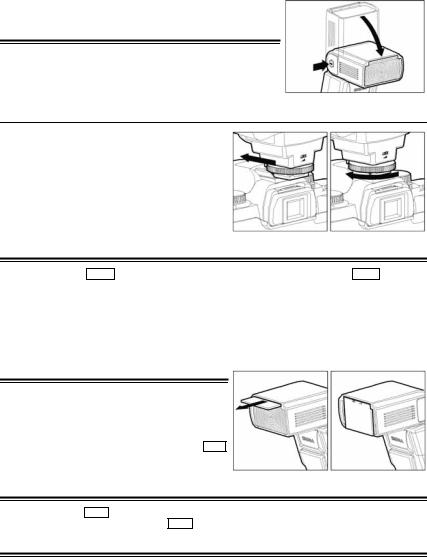Sigma EF-530 User Manual

ENGLISH
Thank you very much for purchasing the Sigma EF-530 DG SUPER EO-TTL II Electronic Flash. This product is specifically developed for the Canon EOS series SLR cameras. Depending on the camera model, functions and operation may vary. Please read this instruction booklet carefully. To add to your enjoyment of photography, the flash has a variety of features. To make the most of all these features and to get the maximum performance and enjoyment from your flash, please read this instruction booklet together with your camera’s instruction manual before using the flash, and also keep it handy for your future reference.
PRECAUTIONS
In order to avoid causing any damage or injury, please read this instruction manual very carefully, paying attention to the cautionary signs below, before using the flash.
Please take special note of the two cautionary signs below.
 Warning !!
Warning !!
 Caution!!
Caution!!
Using the product disregarding this warning sign might cause serious injury or other dangerous results.
Using the product disregarding this caution sign might cause injury or damage.
 Symbol denotes the important points, where warning and caution are required.
Symbol denotes the important points, where warning and caution are required.  Symbol contains information regarding the actions that must be avoided.
Symbol contains information regarding the actions that must be avoided.
 Warning !!
Warning !!
This flash contains high voltage circuits. To avoid electric shock or burns, do not attempt to disassemble the flash. If the outside shell of the unit is broken or cracked, do not touch the mechanism inside.
Do not fire the flash close to eyes. Otherwise the bright light could damage the eyes. Keep at least 1m/3feet distance between face and the flash unit when taking a picture with flash.
Do not touch the synchro terminal of your camera when the flash is attached to the hot shoe. High voltage circuitry could cause an electric shock.
Never use your camera in an environment where flammable, burnable, gas, liquids or chemicals, etc, exist. Otherwise it might cause fire or explosion.
 Caution !!
Caution !!
Do not use this flash unit on any camera other than the Canon EOS series cameras, otherwise the flash may damage the circuitry of these cameras.
This flash unit is not waterproof. When using the flash and camera in the rain or snow or near water, keep it from getting wet. It is often impractical to repair internal electrical components damaged by water.
Never subject the flash and camera to shock, dust, high temperature or humidity. These factors might cause fire or malfunctioning of your equipment.
When the flash is subjected to sudden temperature change, as when the flash unit is brought from a cold exterior to warm interior, condensation might form inside. In such a case, place your equipment in a sealed plastic bag before such a change, and do not use the flash unit until it reaches room temperature.
Do not store your flash in a drawer or cupboard etc. containing naphthalene, camphor or other insecticides. These chemicals will have a negative effects on the flash unit.
Do not use a thinner, Benzene or other cleaning agents to remove dirt or finger prints from the component. Clean with a soft, moistened cloth.
For extended storage, choose a cool dry place, preferably with good ventilation. It is recommended that the flash be charged and fired several times a month, to maintain proper capacitor functioning.
14

DESCRIPTION OF THE PARTS
EXTERNAL PARTS
1.Flash Head |
2.Built-in Wide |
Panel |
3.AF |
Auxiliary Light |
4.Bounce Angle; |
Up and |
Down |
|
5.Bounce Angle; Right and Left |
6.Bounce Lock and Release Button; Up and Down |
7.Swivel |
Lock |
|||||
and Release Button; Right and Left |
8.LCD Panel 9.Battery Cover |
10.Shoe Ring |
11.Shoe |
|
||||
CONTROLS |
|
|
|
|
|
|
|
|
12.MODE Button |
13.<SEL> SELECT Button |
14.< + > Increment Button |
15.< - > Decrement Button |
|||||
16.ZOOM Button |
17.TEST Button 18.LIGHT Button 19.Ready Light |
20.Power Switch |
|
|||||
CAMERA MODELS AND FUNCTIONS
Although this Flash unit has been equipped with numerous functions, depending on the camera model being used some functions may have some limitations. Please confirm the type camera you have from the list below. Please refer to explanations of each function through the instruction manual; If no model information is specified, it means that this function of flash can be used with all type of EOS cameras.
A type camera |
E-TTL(E-TTL II) Compatible EOS SLR cameras |
B type camera |
All other EOS cameras except those listed above |
ABOUT THE BATTERY
This flash unit uses four “AA” type Alkaline dry cell batteries, Ni-Cad or Ni-MH rechargeable batteries. Manganese batteries can also be used but as they have a shorter life than Alkaline batteries, we do not recommend using them. Please replace batteries if it takes more than 30seconds to light the Ready Lamp.
To assure proper electrical contact, clean the battery terminals before installing the batteries.
NiCad batteries do not have standardized contacts. If you use NiCad batteries, please confirm that the battery contacts touch the battery compartment properly.
To prevent battery explosion, leakage or overheating, use four new AA batteries of the same type and brand. Do not mix the type or new and used batteries.
Do not disassemble or short-circuit the batteries, or expose them fire or water; they may explode. Do not recharge the batteries other than Ni-Cd or Ni-MH rechargeable batteries.
When the flash will not be used for an extended period of time, remove the batteries from the flash to avoid the possibility of damage from leakage.
Battery performance decreases at low temperatures. Keep batteries insulated when using the flash in cold weather.As with any flash, it is recommended you carry spare batteries when on a long trip or when
photographing outdoors in cold weather.
BATTERY LOADING
1.Be sure to set the Power Switch to the off position then slide the battery cover in the direction of the arrow to open.
2.Insert four AA size batteries into the battery chamber. Be sure the + and – ends of the batteries are aligned according to the diagram in the chamber.
3.Close the cover.
4.Slide the Power Switch to the ON position. After few seconds the Ready Lamp will light, indicating that the flash unit can be fired.
5.Please press the “Test Button” to be sure that the flash is working properly.
AUTO POWER OFF
To conserve battery power, the flash unit automatically turns itself off when the flash is not used within approximately 90 seconds. To turn the flash on again, depress the “TEST” button or the camera shutter button halfway. Please note that the “Auto Power Off” mechanism does not work with wireless TTL flash mode, normal slave flash, and designated slave flash modes.
ERROR INDICATION
If the battery power is not sufficient or there is an electric information error between the camera and flash unit, the “Flash Coverage Angle” will blink on the LCD panel. When this occurs, turn the power switch off and on.
15

If it still blinks after this procedure, check the battery power.
ADJUSTING THE FLASH HEAD
Depress the Bounce “Up and Down” Lock and Release Button and adjust the flash head to the desired position.
If  appears on the LCD panel when you turn on the flash, and if this mark blinks, then the flash head is adjusted to an incorrect position.
appears on the LCD panel when you turn on the flash, and if this mark blinks, then the flash head is adjusted to an incorrect position.
ATTACHING AND REMOVING THE FLASH TO AND FROM THE CAMERA
Be sure to turn off the Power Switch, then insert the
Shoe Base into the hot shoe on the camera and turn the
Shoe Locking Ring until it is tight.
When you attach or remove the flash, grasp the bottom of the flash to prevent damage to the shoe foot and the camera’s hot shoe.
If the camera’s built-in flash is set in up position, please close it before you attach the flash unit.
To remove the flash, rotate the shoe-locking ring in the opposite direction of ◄LOCK mark, until it stops.
SETTING OF FLASH COVERAGE ANGLE
When you press the ZOOM button, the  symbol appears. Each time you press the ZOOM button, the LCD panel display will change and indicate the zoom position in sequence as follows.
symbol appears. Each time you press the ZOOM button, the LCD panel display will change and indicate the zoom position in sequence as follows.
24mm → 28mm → 35mm → 50mm → 70mm → 85mm → 105mm → (Auto) Generally, in the ETTL (TTL) mode, the flash will automatically set the zoom position according to the focal length of your lens.
When you turn on the main switch, the flash will memorize and set the zoom head position to the last setting used.If you use a lens wider than the flash head setting, there may be under exposed areas around the edge of the picture.Depending on the flash head setting, the flash’s Guide Number will be changed.
WIDE PANEL
This flash is equipped with a built in type wide panel, which can provide ultra wide 17mm angle of coverage. Slide out the wide panel and flip it down to cover flash’s head. Then the coverage angle setting of the flash will be set to 17mm automatically.
If the built-in wide panel comes off accidentally, the ZOOM button will not function. In this case please contact the store where the flash was purchased or a Sigma service station.
LCD PANEL ILLUMINATION
When you press the LIGHT button, the LCD panel will illuminate for about 8 seconds. The illumination stays on longer than 8 seconds if you press the LIGHT button once again.
ETTL (TTL) AUTO FLASH
In the TTL AUTO Mode, the camera will control the amount of flash lighting to get the appropriate exposure for the subject.
“A” type cameras can be set in ETTL mode. “B” type cameras can be set in TTL mode.
1.Set the camera’s mode to Full-AUTO Mode. ( Usually □ Mode. If the camera does not have □ Mode, set to P Mode.)
16

2.Turn on the power switch of the flash, the ETTL (TTL) mark will appear on the LCD panel and the flash will start charging.
3.Focus on your subject.
4.Check that the subject is located within the effective distance range indicated on the LCD panel.
5.Press the shutter button, after the flash is fully charged.
Note: When the flash is fully charged, the ready light in the viewfinder appears.
When the camera receives the appropriate exposure, the ETTL (TTL) mark on the LCD panel will appear for 5 seconds. If this indication does not appear, the flash illumination is not sufficent for that situation. Please re-take the picture at a closer distance.
The AF Auxiliary Light will turn on automatically as you focus on a dark area. Note: Effective distance is up to about 0.7 to 9 meters (2.3-29.5 feet).
When the camera is set to ‘Creative Zone’, the flash will be set to TTL / ETTL mode.
When the flash is fully charged, the flash mark will appear in the finder. If the shutter is released before the flash is fully charged, the camera will take the picture at a slow shutter speed with no flash.
USING FLASH IN OTHER CAMERA MODES (Except EOS700, 750, 850)
Shutter Speed Priority Setting
By selecting the Tv mode of the camera, you can set the shutter speed from 30sec. to 1/X sync speed. When you set the desired shutter speed, the camera will select the appropriate aperture value for the scene. If the subject is too light or too dark, the aperture value indicator will blink and show the limit values (maximum or minimum aperture). In such as case, the camera proceeds to take a flash photograph at the limit value. Thus, the main subject in the picture should be exposed correctly, but the background may become under or over exposed.
Aperture Priority Setting
By selecting the Av mode of your camera, the camera will select the appropriate shutter speed for the scene. If the subject is too bright or too dark, the shutter speed indicator will blink and show the limit (highest or slowest shutter speed) value. The highest shutter speed will be limited to the camera’s normal flash synchronization speed. In such a case, the camera proceeds to take a flash photograph at the limit value. Thus, the main subject in a picture should be exposed correctly, but the background may become under or overexposed.
When used with M Mode
You can set the desired aperture value and shutter speed from 30 seconds to the camera’s flash sync speed. If the camera’s exposure requires more light to achieve correct exposure for the inputted values, the flashgun will provide sufficient light to give the correct exposure, within the working range of the flashgun.
LIMITS OF CONTINUOUS SHOOTING
To prevent overheating of the flashgun’s circuitry, do not use your flash unit for at least 10 minutes after continuously firing the flash for the number of exposures shown in the table below.
Mode |
Number of Flash Exposures |
TTL, M(1/1,1/2) |
15 Continuous Flash Shots |
M(1/4, 1/8) |
20 Continuous Flash Shots |
M(1/16-1/32) |
40 Continuous Flash Shots |
Multi |
10 Cycle |
MANUAL FLASH OPERATION
Manual flash is provided for shooting subjects when the correct exposure is difficult to obtain in the TTL mode. In the manual flash mode, you can set the flash power level from 1/1 (full) to 1/128 power in one step increments.
1.Set the camera’s exposure mode to M.
2.Press the MODE button on the flash unit to select M.
3.The flash power output value blinks when you press the SEL button.
4.Press + or - button to set the desired flash power output.
17
